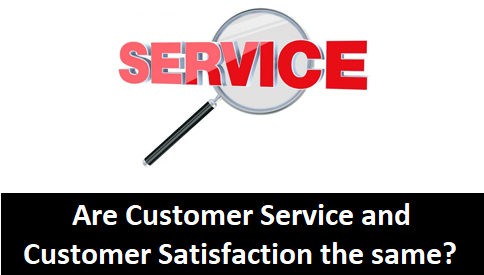Are Customer Service &
Customer Satisfaction the Same?
Tip, they are related, but not the same. Companies improve customer service skills in order to get better customer satisfaction. It’s a cause and effect relationship – just like effective training causes better performance. Service is what your company does. Satisfaction is how the customers feel about what your company did.
• Service that exceeds expectations produces excellent satisfaction
• Service that meets expectations results in good satisfaction
• Service that is below their expectations will inevitably cause dissatisfaction
Every company wants satisfied customers because they’re more likely to return and do business again plus they are more likely to refer others. A strong track record of meeting and exceeding expectations will make it significantly easier to grow the business.
How to Improve Customer Service – Strategies and Tips

A difficult two-pronged challenge for companies is to set their service standards high enough and then have their employees skillfully adapt to the natural variations in customers. Tip: learning how to improve customer service is more of an art form than a science.
It isn’t always about doing more and more – better and better for your customers. Think about this: you go into a restaurant and get seated. After a server passes by two or three times you call out to him and ask for a coffee. He tells you to walk over to the lineup. When you get up to the counter let the barista know what you want. Don’t forget to pay for it first because we don’t trust our customers enough to let them to pay later. Then move over by the next counter and wait for your coffee to be put on top. If you’re really fortunate your seat will still be available when you return. The server then smiles and wishes you a great day. You most likely wouldn’t be thrilled because it wasn’t what you expected, but Starbucks has built a large international company based on that level of service and their coffee is more expensive.
Let’s look at a company in a different type of environment. In the sign business they might train the staff to add an extra day onto their manufacturing time and initially inform their clients their signs will be available for pickup one day after the products are likely to be completed. Then when they call a day early it will be received as excellent service.
The reverse would also be true. If you tell them that it will be ready on Monday and it isn’t completed until Tuesday then it’s likely to be perceived to be poor service. The only real difference is the expectation that your company established. It’s possible that in both examples the order was ready at the identical time.
If a client actually does need their order on Monday and your company has instituted the extra day policy then it will be easier to adjust the schedule and meet that requirement. Far too many companies keep getting themselves into a bind when they don’t have to. Sometimes you don’t have to go the extra mile to improve customer service and skillfully deliver better satisfaction.
The Key Point

There is another set of expectations: Core Expectations. These are expectations that mainly revolve around how people expect to be treated by others. They are about respect. Some people expect a very high level of respect while others don’t expect to get much at all. Core Expectations are also situational: how you expect to get treated by a police officer is likely different from how you expect to get treated by a sales clerk. A chiropractor is different again and so is the person in front of you in a theater lineup.
These interpersonal expectations are important. It’s been reported that several studies have shown that 68% of the time a client leaves it is because of how they were treated and how they were made to feel. Understanding Core Expectations will help you to set and improve customer service standards.
I’ll tell you about my wife. When we go into a retail store and the staff isn’t busy serving other people, but they don’t acknowledge us or attempt to serve us, there is a specific amount of time before she signals that we are leaving. It’s about two minutes. After that there is no way she will do business with that company again. She’s not that much different from anybody else. Personal respect is a core expectation. If you don’t meet or exceed them then there is absolutely no way to improve customer service.
How to Improve Customer Service and Exceed Expectations
There are some interesting strategies to consistently exceed expectations and build your word of mouth referrals.
Stay with me for a minute here, it’s an interesting story. A mattress retailer produced a television commercial and spent good money running it on TV. It was about how their delivery staff wore booties over their shoes when they entered the customers’ homes. They got the idea for the commercial from their customer satisfaction surveys. Their clients commented frequently about how much they appreciated it.
It all sounds great until you realize they spent good money to downgrade exceptional customer satisfaction into good customer satisfaction and heaven forbid if one of their vans runs out of booties. This is clearly not an example of how to improve customer service to increase satisfaction.
You might want to think about the booties your company can develop. They’re small things that cost very little, but really register with your clients. Good booties are extremely valuable. Achieving good customer satisfaction is challenging. It involves communicating expectations well and consistently delivering on them. Shifting that into high customer satisfaction is easy when you understand your booties.
Here’s a tip that works well: be genuinely happy to see your clients. Let’s be realistic, how many times are people happy to see you? The world is pretty much the same for your clients. If you’re happy to see them you’re already exceeding what they expect from the world.
It’s worthwhile to routinely get your staff together and brainstorm for booties. They are simple inexpensive ways of increasing your customer’s satisfaction. Every company has opportunities. Having an ‘inventory of ideas’ means you can give all your customers a booty call. It’s an example of how to improve customer service and it’s good for business.
To discover more about ROCK SOLID Coaching & Consulting.
I hope you liked this article on how to improve customer service skills to get better customer satisfaction.


Amy Kobelt
Glad you made the distinction between satisfaction and service!!
Carly Sauve'
Great article John, I will be sure to read more.
Stanley Odi Onuoha
Nice article John, a very important advice for business owners
Rose DeNaro
The experience we create for our customers is everything…..the worst thing we can do is not make a mistake, it is not using it as an opportunity to give our customers an exceptional experience in how we make it right . Nice thoughts John, I enjoy your writing, Coach Rose.
Dawn Howard Weaver
Hi John,
I love the booty analogy. I actually love that some companies really do that. It stuck out with me as I had this happen and then my expectations of other companies that had to come into my home were at the same level. I was very unhappy that this level didn’t transfer from one company to another.
It would be great if we all had a trademark “booty” that set us apart. I love the idea.
I, too, like your wife do the same thing. I expect to be greeted and asked how I can be helped especially when it is apparent I need help.
Thanks for the insight and I sincerely hope more companies will consider this. I makes a tremendous difference. I love being made to feel like I really matter as a customer.
Dawn